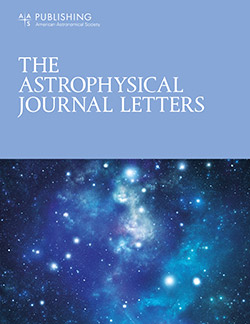SN 2023ixf的早期光谱和密集的星周介质相互作用
IF 8.8
1区 物理与天体物理
Q1 ASTRONOMY & ASTROPHYSICS
引用次数: 7
摘要
摘要研究了超新星SN 2023ixf在爆炸后1.18 ~ 15天的亚夜间节奏光谱的光谱演变。我们确定了高电离发射特征,即与祖恒星周围物质相互作用的特征,这些特征在前7天内逐渐消失,在同一晚上观测到的光谱之间快速演变。我们将其发射谱线及其相对强度与其他早期相互作用的超新星的发射谱线进行了比较,发现其在第一个谱线上与SN 2020pni和SN 2017ahn非常匹配,在较晚的谱线上与SN 2014G非常匹配。为了从物理上解释我们的观察结果,我们将它们与CMFGEN模型进行了比较,CMFGEN模型中包含了文献中红超巨星(RSG)祖星周围受限、致密的星周物质。我们发现,很少有模型能再现在前几个光谱中观测到的N iii (λ 4634.0,4640.6)/C iii (λ 4647.5,4650.0)混合发射谱线,然后它们迅速消失,使这成为一种独特的诊断。从最好的模型中,我们发现质量损失率为10−3 -10−2 M⊙yr−1,远远超过任何稳定风的质量损失率,特别是对于处于检测到的祖星初始质量范围内的RSG。然而,这些质量损失率与其他早期星周相互作用的超新星的损失率相似。利用窄发射特征消失的相位,我们计算出星周物质的外致密半径R CSM,out≈5 × 10 14 cm,平均星周物质密度ρ = 5.6 × 10−14 g cm−3。这与我们从H α发射通量的峰值R CSM计算出的星周物质外半径的下限是一致的,rcsm在< 9 × 10 13 cm。本文章由计算机程序翻译,如有差异,请以英文原文为准。
Early Spectroscopy and Dense Circumstellar Medium Interaction in SN 2023ixf
Abstract We present the optical spectroscopic evolution of SN 2023ixf seen in subnight cadence spectra from 1.18 to 15 days after explosion. We identify high-ionization emission features, signatures of interaction with material surrounding the progenitor star, that fade over the first 7 days, with rapid evolution between spectra observed within the same night. We compare the emission lines present and their relative strength to those of other supernovae with early interaction, finding a close match to SN 2020pni and SN 2017ahn in the first spectrum and SN 2014G at later epochs. To physically interpret our observations, we compare them to CMFGEN models with confined, dense circumstellar material around a red supergiant (RSG) progenitor from the literature. We find that very few models reproduce the blended N iii ( λλ 4634.0,4640.6)/C iii ( λλ 4647.5,4650.0) emission lines observed in the first few spectra and their rapid disappearance thereafter, making this a unique diagnostic. From the best models, we find a mass-loss rate of 10 −3 –10 −2 M ⊙ yr −1 , which far exceeds the mass-loss rate for any steady wind, especially for an RSG in the initial mass range of the detected progenitor. These mass-loss rates are, however, similar to rates inferred for other supernovae with early circumstellar interaction. Using the phase when the narrow emission features disappear, we calculate an outer dense radius of circumstellar material R CSM,out ≈ 5 × 10 14 cm, and a mean circumstellar material density of ρ = 5.6 × 10 −14 g cm −3 . This is consistent with the lower limit on the outer radius of the circumstellar material we calculate from the peak H α emission flux, R CSM,out ≳ 9 × 10 13 cm.
求助全文
通过发布文献求助,成功后即可免费获取论文全文。
去求助
来源期刊

Astrophysical Journal Letters
ASTRONOMY & ASTROPHYSICS-
CiteScore
14.10
自引率
6.30%
发文量
513
审稿时长
2-3 weeks
期刊介绍:
The Astrophysical Journal Letters (ApJL) is widely regarded as the foremost journal for swiftly disseminating groundbreaking astronomical research. It focuses on concise reports that highlight pivotal advancements in the field of astrophysics. By prioritizing timeliness and the generation of immediate interest among researchers, ApJL showcases articles featuring novel discoveries and critical findings that have a profound effect on the scientific community. Moreover, ApJL ensures that published articles are comprehensive in their scope, presenting context that can be readily comprehensible to scientists who may not possess expertise in the specific disciplines covered.
 求助内容:
求助内容: 应助结果提醒方式:
应助结果提醒方式:


